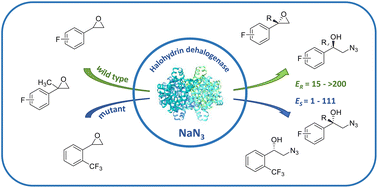Biocatalytic approach to chiral fluoroaromatic scaffolds†
Abstract
Ten different fluorinated aromatic epoxides have been tested as potential substrates for halohydrin dehalogenase (HHDH) HheC. The majority of investigated epoxides are useful building blocks in synthetic chemistry applications, with a number of them being polysubstituted. Moderate to high enantioselectivities (ER = 15 → 200) were observed in azidolysis, allowing the synthesis of enantioenriched (R)-azido alcohols containing fluorine in the molecule. In the case where a reaction runs over 50% conversion, enantiopure (S)-epoxides are also available. While o-F-styrene oxide was easily converted into a product, a sterically challenging o-CF3-derivative was not accepted by HheC. In silico probing of the binding site indicates that, in order to accommodate an o-CF3-derivative in the HheC active site, it is necessary to eliminate steric hindrance. Hence, we extended our research by probing several available HheC variants containing relevant modifications in the active site. The active mutant P84V/F86P/T134A/N176A (named HheC-M4) was identified, showing not only high activity towards o-CF3-styrene oxide, but also inverted enantioselectivity (ES = 27). Since (S)-enantioselective HHDHs are rare and therefore valuable for their synthetic application, this enzyme was screened on the initial panel of substrates. The observed (S)-enantioselectivity (ES = 1–111) is ascribed to the formation of the additional space by introduced mutations in HheC-M4, which is also confirmed by classical MD simulations. Successive molecular docking demonstrated that this newly formed tunnel located close to the protein surface is a critical feature of HheC-M4, representing a novel binding site.

- This article is part of the themed collection: Biocatalysis: A cross-journal collection


 Please wait while we load your content...
Please wait while we load your content...